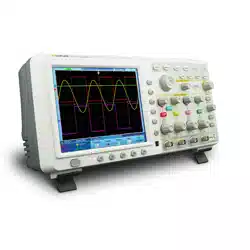Loading ...
Loading ...
Loading ...

5.Advanced User Guidebook
28
2. Select FFT in the bottom menu.
3. Select Source in the right menu; select ① in the left source menu.
4. Select Window in the right menu; select the proper window type in the left menu.
5. Select Format as Vrms or dB in the right menu.
6. Select Horizontal in the right menu; select repeatedly to make the
symbol in
front of Hz, turn the G knob to adjust the horizontal position of FFT waveform;
then select to make the
symbol in front of the Hz/div below, turn the G knob
to adjust the time base of FFT waveform.
7. Select Vertical in the right menu; do the same operations as above to set the
vertical position and voltage division.
To select the FFT window
■ There are 6 FFT windows. Each one has trade-offs between frequency resolution
and magnitude accuracy. What you want to measure and your source signal
characteristics help you to determine which window to use. Use the following
guidelines to select the best window.
Type
Characteristics
Window
Rectangle
Best solution for frequency, worst for magnitude.
Best type for measuring the frequency spectrum of
nonrepetitive signals and measuring frequency
components near DC.
Recommend to use for:
Transients or bursts, the signal level before and
after the event are nearly equal.
Equal-
amplitude sine waves with frequencies
those are very close.
Broadband random noise with a relatively slow
varying spectrum.
Hanning
Good for magnitude, but poorer frequency
resolution than Hamming.
Recommend to use for:
Sine, periodic and narrow band random noise.
Transients or bursts where the signal levels
before and after the event are significantly
different.
Loading ...
Loading ...
Loading ...
